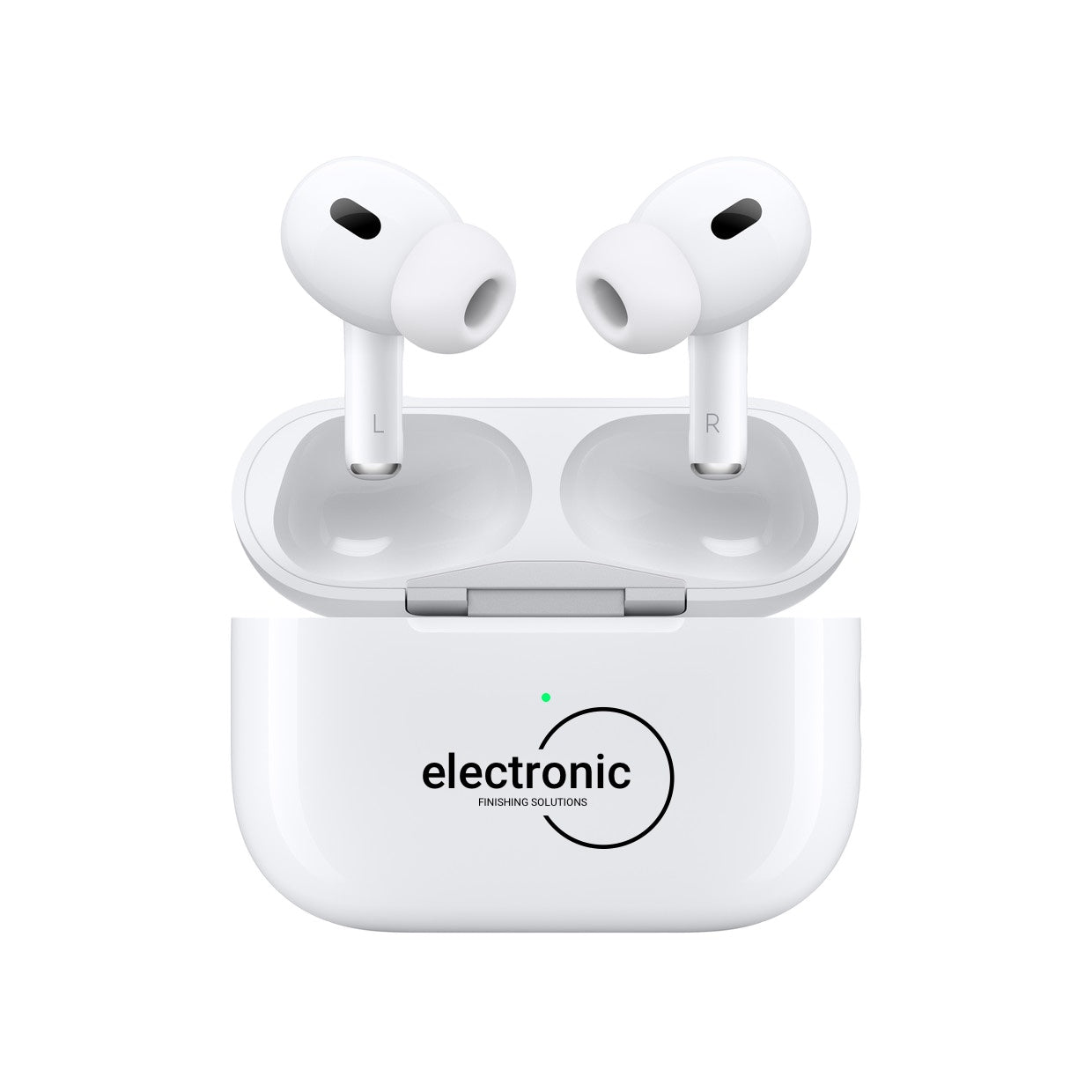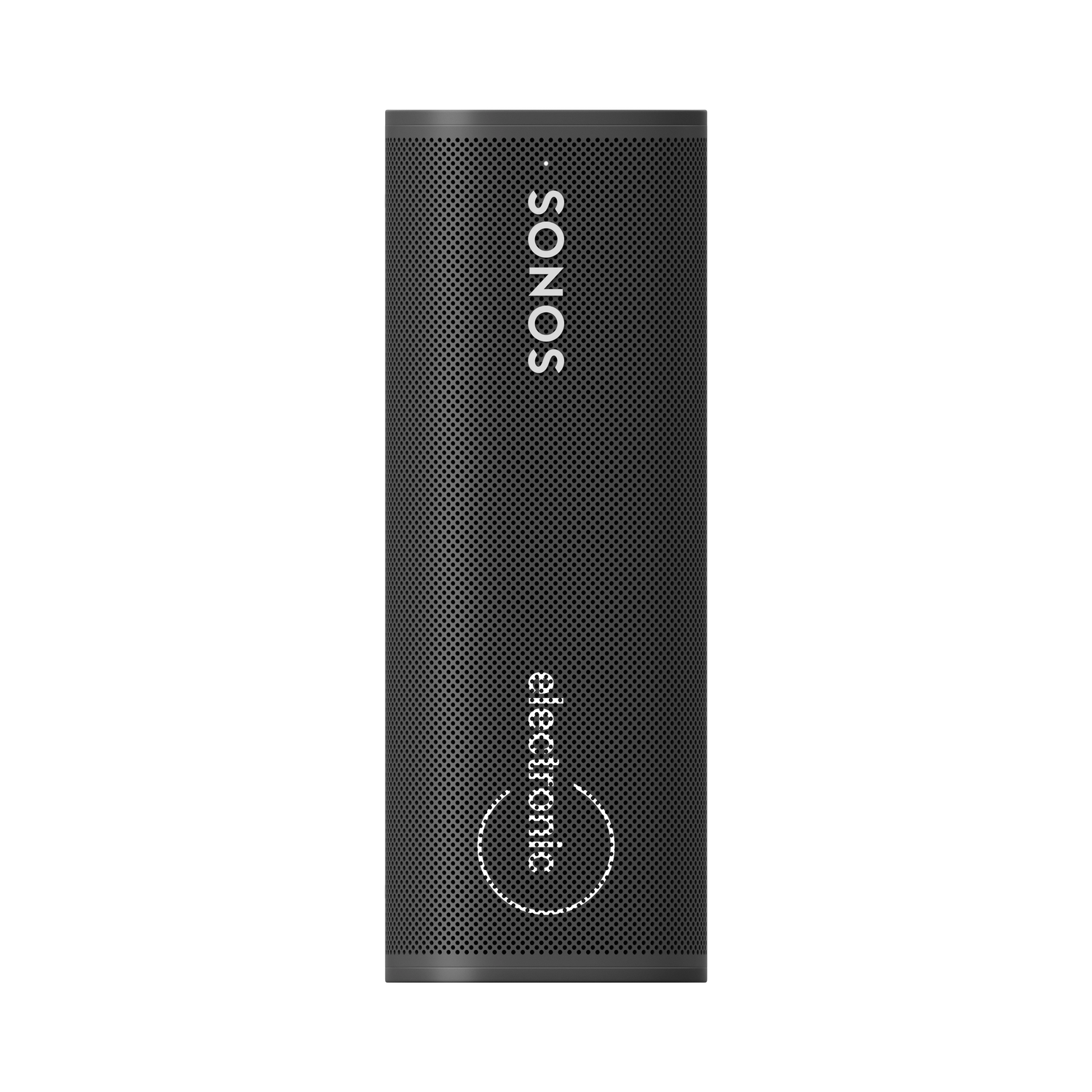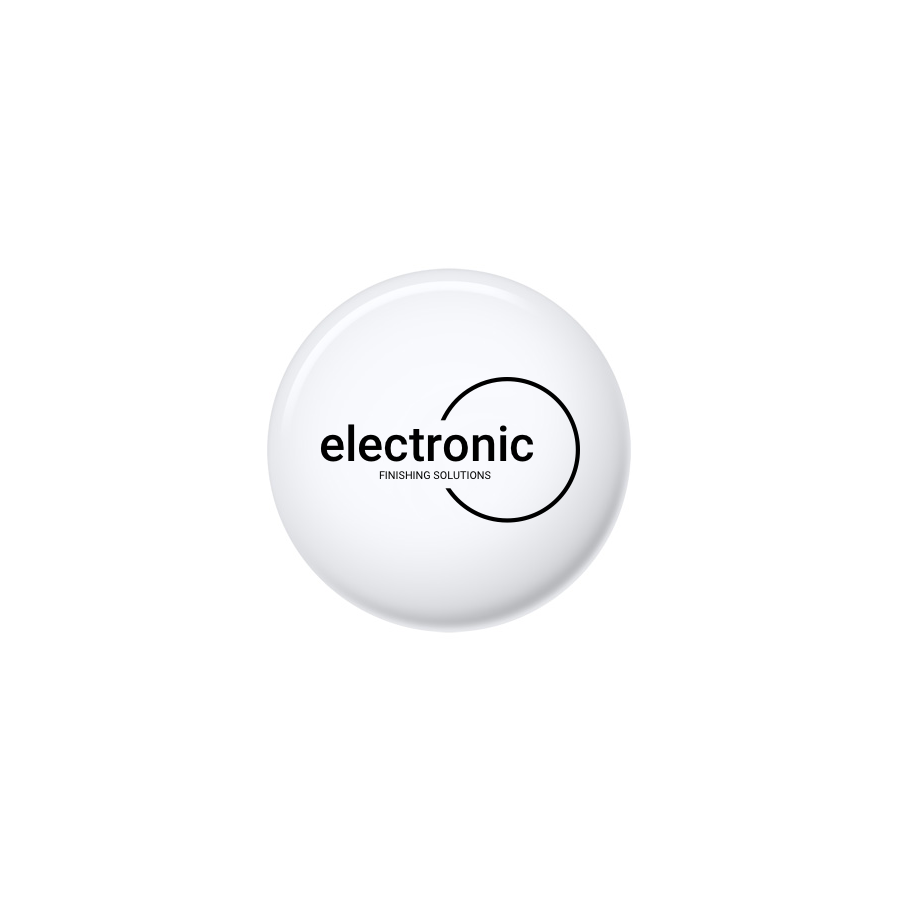Unleash the Power of Virtual Events
Want to create virtual events that captivate your audience and deliver real results? This listicle provides ten proven virtual event engagement ideas to transform passive attendees into active participants. Discover how interactive polling, gamification, networking lounges, celebrity appearances, virtual exhibits, and more can elevate your online events. These strategies boost engagement, generate valuable attendee data, and help achieve your event objectives. From Fortune 100 companies to tech startups, these virtual event engagement ideas will help you maximize impact.
1. Interactive Polling and Live Q&A
Interactive polling and live Q&A sessions are essential tools for boosting audience engagement during virtual events. These features transform passive viewers into active participants, fostering a dynamic environment that encourages interaction and knowledge sharing. By collecting real-time feedback and facilitating direct communication between speakers and attendees, you can create a more personalized and impactful event experience. This approach not only allows you to gauge audience opinions and tailor content on the fly but also builds a sense of community among attendees. This method deserves its place on this list because it directly addresses a key challenge of virtual events – maintaining audience attention and participation.
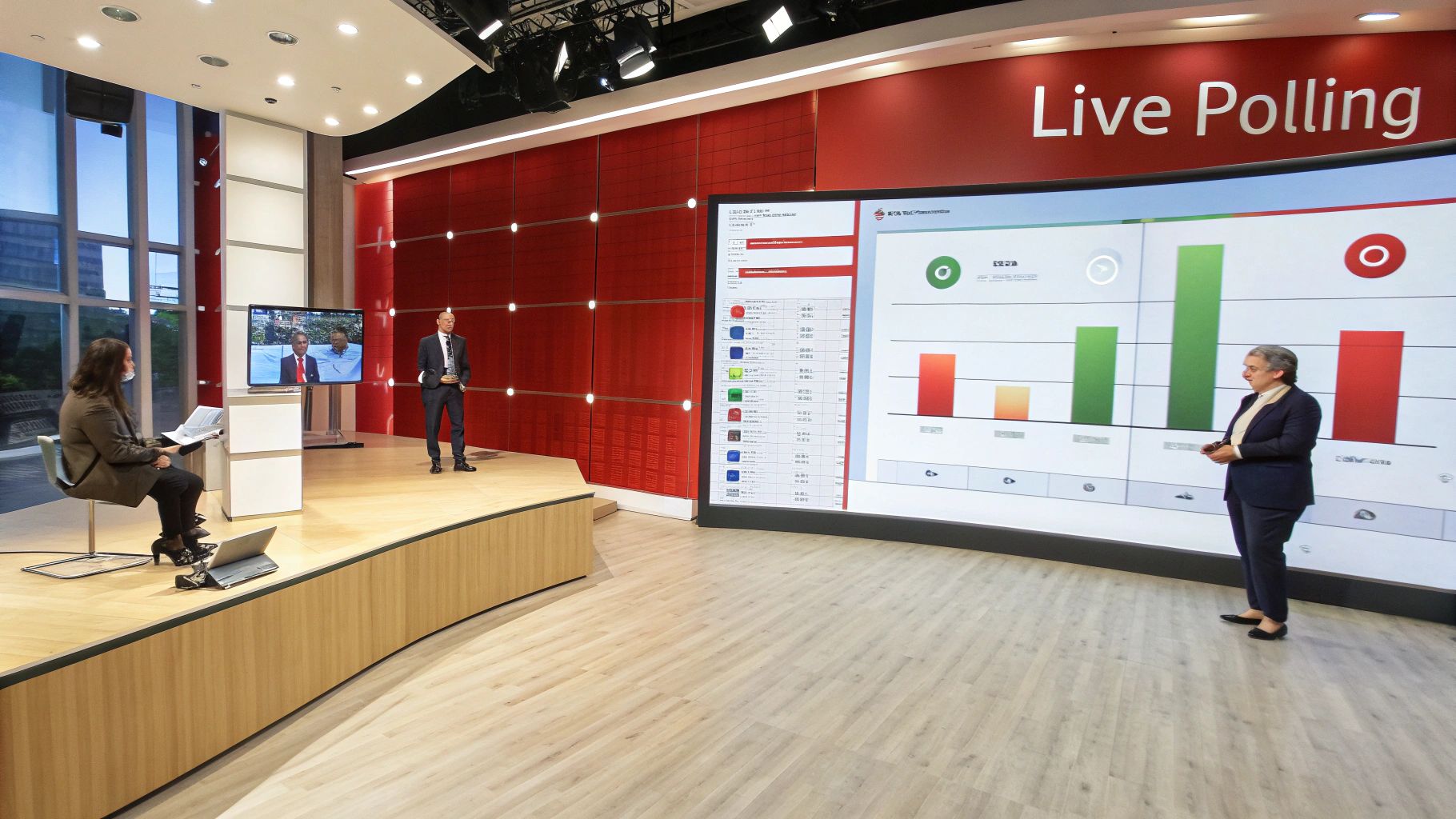
Interactive polling offers multiple question formats, ranging from multiple choice and ratings scales to open-ended questions, catering to diverse data collection needs. Real-time visualization of results through word clouds, graphs, and charts further enhances audience engagement and provides valuable insights. Furthermore, integrated moderation capabilities for Q&A sessions ensure a smooth and controlled flow of information, allowing speakers to address relevant questions effectively. This feature is particularly beneficial for large-scale virtual events where managing a high volume of questions can be challenging. Integrating these tools directly into your presentation slides allows for seamless transitions and a more cohesive viewing experience.
Successful Implementations:
- Salesforce World Tour: Leveraged Slido to collect over 2,000 questions throughout their virtual event series, demonstrating the scalability and effectiveness of this tool.
- TED Conferences: Incorporates live polling during talks to illustrate concepts in real-time and gauge audience understanding, making complex topics more accessible.
- HubSpot's INBOUND conference: Utilizes audience polling to personalize breakout sessions, ensuring attendees receive the most relevant and valuable information.
Actionable Tips for Implementation:
- Pace Yourself: Limit polls to 2-3 per hour to maintain engagement and avoid poll fatigue.
- Drive the Conversation: Use poll results to steer the discussion and delve deeper into topics of interest.
- Seed Questions: Prepare some initial questions for the Q&A to encourage participation and overcome audience hesitation.
- Follow Up: Address unanswered questions after the event to demonstrate attentiveness and provide comprehensive information.
- Set the Precedent: Use polling early in the event to establish an interactive atmosphere.
Pros and Cons:
Pros:
- Increased audience participation (up to 30-40%)
- Valuable data on attendee preferences
- Fosters a sense of community and shared experience
- Enables real-time content adjustment based on feedback
- Low barrier to participation compared to verbal interaction
Cons:
- Requires stable internet connection for all participants
- Potential for distraction if overused
- Can be challenging to manage large volumes of questions
- Risk of poll fatigue
Popular Platforms: Slido, Mentimeter, Poll Everywhere, WebEx Events
When and Why to Use This Approach:
Interactive polling and live Q&A are particularly effective for:
- Large-scale virtual conferences and events: Facilitates audience participation and interaction in a large group setting.
- Webinars and online training sessions: Gauges understanding and addresses questions in real-time.
- Product demos and launches: Collects valuable feedback on new features and offerings.
- Internal company meetings and town halls: Encourages employee engagement and facilitates two-way communication.
By incorporating interactive polling and live Q&A sessions, you can significantly enhance the engagement and overall effectiveness of your virtual events. These tools provide a valuable platform for collecting real-time feedback, fostering audience participation, and creating a more dynamic and interactive experience for all involved. This approach is highly relevant for Fortune 100 companies, tech startups, corporate marketing teams, venture capital firms, and event coordinators seeking to maximize the impact of their virtual events and achieve their communication objectives.
2. Gamification and Virtual Challenges
Gamification and virtual challenges inject a dose of playful competition and achievement into your virtual event, transforming passive attendees into active participants. This dynamic engagement tactic leverages game mechanics like points, leaderboards, badges, and interactive challenges to incentivize attendees to explore more content, attend more sessions, and ultimately, retain more information. By tapping into attendees' natural desire for recognition and reward, gamification can significantly elevate the overall event experience.
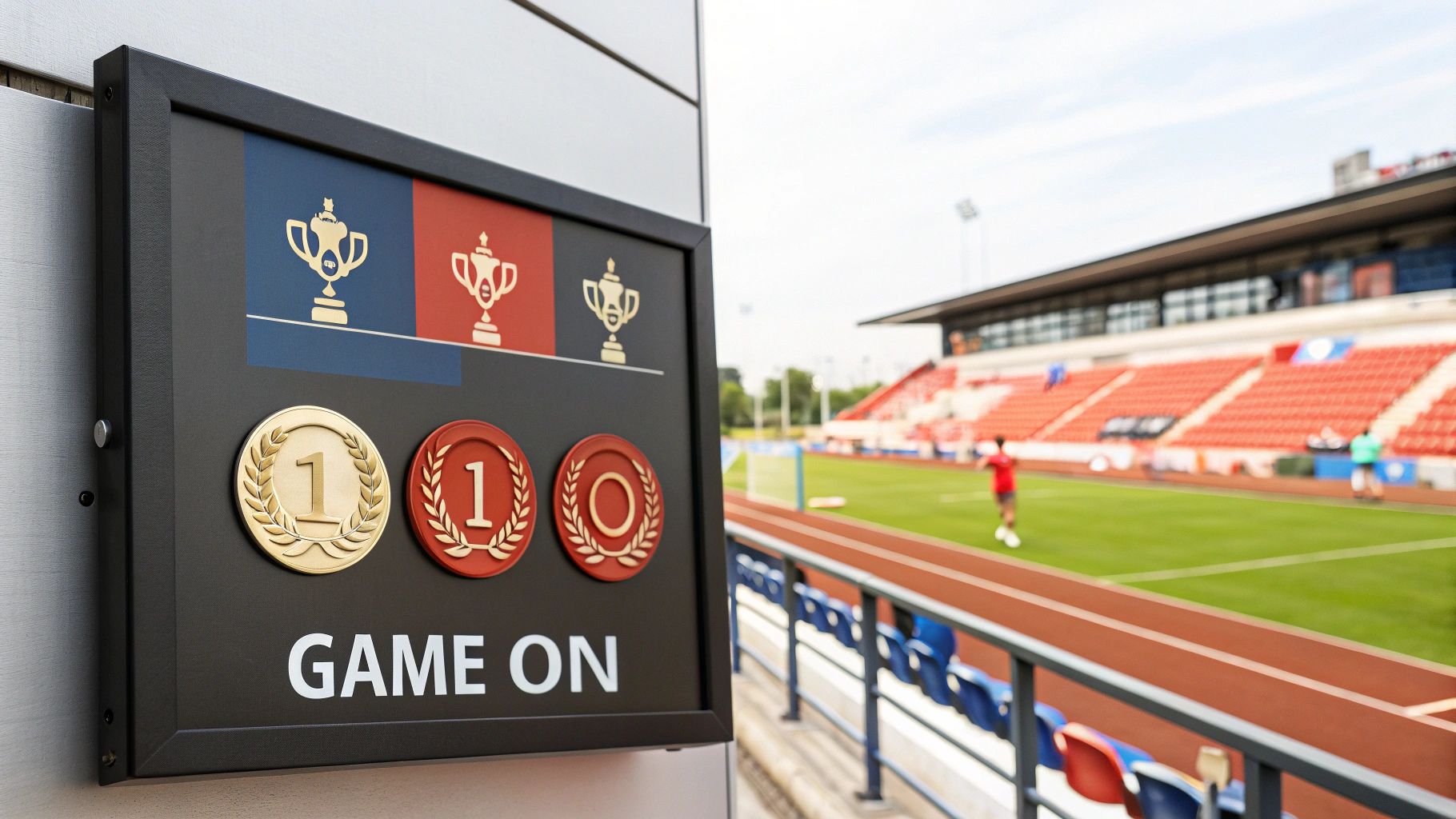
Gamification works by awarding points for specific actions, such as attending keynotes, participating in polls, visiting sponsor booths, or completing quizzes related to session content. These points contribute to individual progress, often visualized on a leaderboard, fostering friendly competition amongst attendees. Digital badges and achievements serve as virtual trophies, recognizing specific accomplishments and further motivating engagement. Challenges can take various forms, including virtual scavenger hunts, timed trivia competitions, and interactive puzzles, adding an element of fun and exploration to the event.
Examples of Successful Implementation:
- Salesforce's Dreamforce: Their "Trailblazer" challenges awarded points for attending sessions, completing quizzes, and engaging in social media activities, driving significant attendee interaction.
- Adobe Summit: The "Summit Sneaks Challenge" encouraged attendee participation by allowing them to vote on innovative product pitches and earn points for their involvement.
- AWS re:Invent: A virtual scavenger hunt across different virtual booths and sessions encouraged attendees to explore the full breadth of the event's offerings.
Tips for Effective Gamification:
- Simplicity is Key: Ensure the game mechanics are easy to understand and participate in, regardless of technical proficiency.
- Balance is Crucial: Strike a balance between competitive elements and the core educational value of your event. Don't let the game overshadow the content.
- Meaningful Rewards: Offer prizes that resonate with your target audience, whether it's exclusive content, gift cards, or industry recognition.
- Variety is the Spice of Life: Create diverse challenge types to cater to different attendee motivations and learning styles.
- Guide the Journey: Use gamification to strategically guide attendees through your desired event flow, highlighting key sessions and sponsors.
- Real-time Feedback: Provide real-time progress indicators and feedback to keep attendees engaged and motivated.
Pros:
- Increased attendee engagement time (up to 70% in some cases)
- Improved content retention through active participation
- Encourages exploration of more event content
- Creates memorable experiences that differentiate your event
- Provides additional sponsorship opportunities through branded challenges
Cons:
- Can be technologically complex to implement effectively
- Requires significant pre-event planning and platform integration
- May alienate non-competitive attendees if poorly balanced
- Could distract from core content if overdone
- Needs clear explanation to ensure all attendees understand how to participate
Why Gamification Deserves Its Place:
In a virtual environment, maintaining attendee focus and engagement can be challenging. Gamification provides a powerful solution by transforming passive attendees into active participants. It incentivizes exploration, encourages interaction, and ultimately, maximizes the impact of your virtual event. This approach is particularly effective for Fortune 100 companies, tech startups, corporate marketing teams, venture capital firms, and event coordinators looking to create engaging and memorable virtual experiences that deliver tangible results. By fostering a sense of play and achievement, gamification ensures that your virtual event stands out from the crowd and delivers lasting value to both attendees and sponsors.
3. Breakout Rooms and Networking Lounges
Breakout rooms and networking lounges are essential virtual event engagement ideas, offering dedicated spaces for smaller, more intimate conversations within larger online gatherings. They address one of the biggest challenges in virtual events: effective networking. By creating these virtual spaces, attendees can connect with peers, delve into specific topics, and build meaningful relationships that are often difficult to foster in main session formats. This focused interaction fosters a sense of community and encourages active participation, leading to a more enriching event experience for everyone involved.
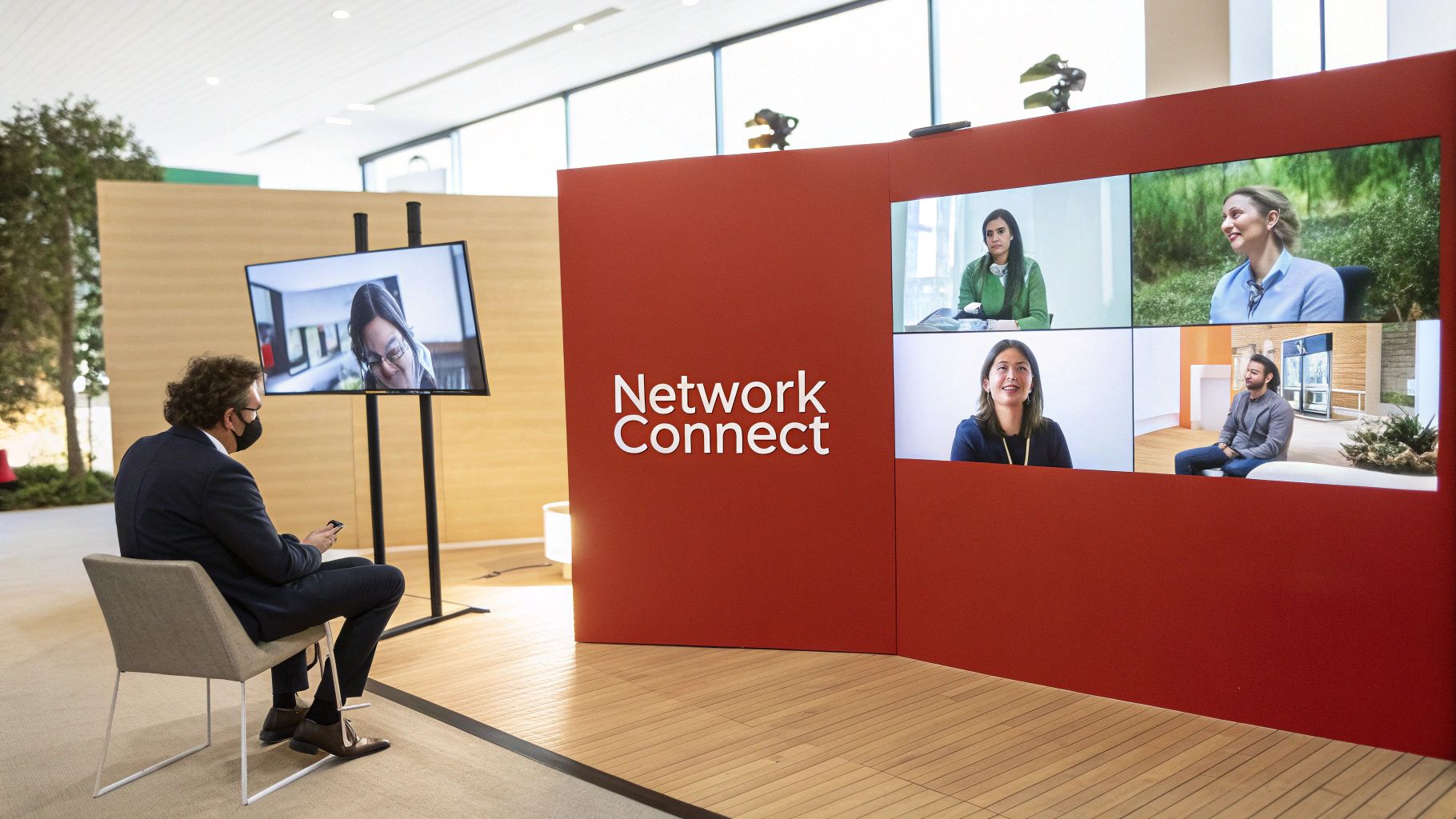
These spaces can be configured with various features to maximize engagement. Think topic-based discussion rooms, randomized networking encounters, and flexible room configurations (moderated or open). Interest-matching algorithms can connect attendees with shared interests, while timed rotation options ensure everyone has a chance to interact with different individuals. Robust text, audio, and video interaction capabilities provide a seamless communication experience. For a deeper dive into the technical aspects and best practices, you can learn more about Breakout Rooms and Networking Lounges.
Several successful examples demonstrate the power of breakout rooms and networking lounges. Zoom's Zoomtopia utilized AI-powered networking to match attendees based on shared professional interests. Web Summit created topic-based virtual lounges where industry experts hosted informal Q&A sessions. TEDx Global facilitated local connections within a global event by using regional breakout rooms. EventMB's virtual summit employed 'birds of a feather' networking tables organized by job function, encouraging peer-to-peer learning and connection.
Why use breakout rooms and networking lounges? They are incredibly effective for Fortune 100 companies, tech startups, corporate marketing teams, venture capital firms, and event coordinators looking to foster authentic connections and drive deeper engagement in their virtual events. They offer a structured yet informal environment ideal for targeted networking and in-depth discussions.
Pros:
- Creates more intimate connections: Smaller groups overcome the impersonal feeling often associated with large virtual events.
- Increases overall participation: Reduced social barriers in smaller groups empower more attendees to contribute.
- Allows for specialized discussions: Topic-focused rooms cater to niche interests and facilitate expert-led conversations.
- Provides attendee-driven content opportunities: Attendees can lead discussions and share their expertise.
- Offers sponsors targeted engagement opportunities: Sponsors can host specialized lounges and interact with key demographics.
Cons:
- Requires clear facilitation: Well-trained facilitators are essential to prevent awkward silences and guide productive conversations.
- Can be technically challenging: Some participants may struggle with the technology, necessitating clear instructions and technical support.
- Risks fragmentation of audience: Poorly scheduled breakouts can pull attendees away from main sessions and dilute the overall event experience.
- May lead to uneven experiences: Group dynamics can vary, leading to some groups having more engaging conversations than others.
- Needs thoughtful moderation: Moderators are key to keeping conversations on track and ensuring respectful interactions.
Tips for Effective Implementation:
- Assign facilitators: A dedicated facilitator in each room can guide discussions, encourage participation, and ensure a positive experience.
- Provide clear prompts: Discussion questions or prompts can spark conversation and prevent awkward silences, particularly valuable for tech startups and corporate teams seeking specific feedback.
- Limit breakout sessions: 15-20 minute sessions maintain energy levels and prevent attendee fatigue.
- Create a mix of structured and unstructured opportunities: Offer a balance of moderated discussions and open networking time.
- Allow attendee-created rooms: Empower attendees to create their own topic-based rooms, fostering organic networking opportunities, perfect for venture capital firms and event coordinators.
- Send pre-event communications: Clear instructions on how the networking features work will ensure a smooth experience for all participants, particularly beneficial for Fortune 100 companies with diverse technological literacy.
By following these tips and considering the pros and cons, you can leverage breakout rooms and networking lounges to elevate your virtual event engagement and achieve your event goals. These interactive spaces are instrumental in creating meaningful connections and fostering a sense of community within the virtual landscape.
4. Interactive Workshops and Hands-on Labs
Looking for dynamic virtual event engagement ideas? Interactive workshops and hands-on labs offer a powerful way to transform passive attendees into active learners, making them a must-have for any engaging virtual event. Unlike traditional webinar formats where participants primarily observe, this approach emphasizes learning by doing. Participants apply concepts in real-time, leading to significantly increased knowledge retention and satisfaction. This makes them particularly appealing to Fortune 100 companies, tech startups, corporate marketing teams, venture capital firms, and event coordinators seeking impactful virtual experiences.
These sessions provide practical, applicable skills through guided instruction, collaborative exercises, and immediate feedback. Features like live demonstrations with follow-along components, digital whiteboards for brainstorming, and downloadable workbooks and materials create a rich learning environment. Screen sharing for troubleshooting and real-time instructor feedback ensure participants receive personalized support. Project-based outcomes solidify learning and provide tangible takeaways, while breakout rooms facilitate team exercises and foster collaboration. Learn more about Interactive Workshops and Hands-on Labs for deeper insights.
Why Choose Interactive Workshops and Hands-on Labs?
This approach deserves its place on the list of top virtual event engagement ideas because it addresses a key challenge: making online events truly interactive. It moves beyond passive consumption and encourages active participation, leading to deeper understanding and better skill development. Specifically, workshops and labs:
- Increase knowledge retention by up to 75% compared to lecture-only formats: Active participation and hands-on practice solidify learning more effectively than passive listening.
- Create tangible value through immediate skill application: Participants walk away with new skills they can apply directly to their work.
- Provide deeper engagement through active participation: Hands-on activities keep attendees focused and invested in the learning process.
- Offer differentiated content from typical webinars: This format breaks the monotony of traditional online presentations and offers a more engaging experience.
- Generate high satisfaction ratings and positive post-event feedback: The interactive nature and tangible learning outcomes lead to greater participant satisfaction.
Examples of Successful Implementation:
Several organizations have successfully leveraged this approach to create engaging virtual experiences.
- Adobe MAX: Their virtual conference features Creative Cloud workshops where participants create projects in real time with expert guidance.
- GitHub Universe: Includes hands-on coding labs with repository access, allowing attendees to practice coding in a live environment.
- Tableau Conference: Offers data visualization workshops where attendees use their own data to create interactive dashboards and reports.
- Miro: Hosted collaborative design thinking workshops using their digital whiteboard platform, showcasing the power of visual collaboration tools.
These examples highlight the versatility of interactive workshops and labs across different industries and skill sets. They demonstrate how this format can be adapted to provide engaging learning experiences for diverse audiences.
Pros and Cons:
While offering significant benefits, interactive workshops and labs require careful planning and execution.
Pros: As mentioned earlier, the pros include increased knowledge retention, tangible value creation, deeper engagement, differentiated content, and high satisfaction ratings.
Cons:
- Requires more technical preparation than standard presentations: Ensuring smooth technical execution requires meticulous planning and testing.
- Limited by participants' technical capabilities and equipment: Varying levels of technical proficiency among participants can pose a challenge.
- Needs lower participant-to-instructor ratios: Smaller groups allow for more personalized attention and support from instructors.
- May create frustration if technology problems occur: Technical glitches can disrupt the flow and negatively impact the learning experience.
- Requires additional preparation time for participants: Attendees may need to install software, download materials, or complete pre-work before the session.
Actionable Tips for Success:
To maximize the effectiveness of your interactive workshops and labs:
- Send preparation instructions and requirements well before the event: This allows participants to prepare adequately and minimizes technical issues during the session.
- Provide downloadable resources and templates in advance: Pre-loaded materials streamline the learning process and allow participants to focus on the activities.
- Include teaching assistants to help with technical issues: Dedicated support staff can quickly address technical problems and ensure a smooth learning experience.
- Build in buffer time for troubleshooting and questions: Allocate extra time to address technical difficulties and answer participant questions.
- Record sessions for later reference when participants practice independently: Recordings allow participants to review the material and practice at their own pace.
- Create a dedicated communication channel for technical support: A designated channel for technical assistance ensures prompt resolution of issues.
- Test all demonstrations on multiple devices and operating systems: Thorough testing ensures compatibility and minimizes technical surprises during the live event.
By carefully considering these tips and understanding the potential challenges, you can leverage the power of interactive workshops and labs to create truly engaging and impactful virtual event experiences that resonate with your target audience. Popularized by organizations like Adobe Creative Cloud events, GitHub Learning Lab, General Assembly, AWS Workshops, and Microsoft Learn, this approach is proving to be a highly effective method for delivering valuable learning experiences in the virtual space.
5. Celebrity Guests and Surprise Appearances
In the competitive landscape of virtual events, capturing and maintaining audience engagement is paramount. One highly effective virtual event engagement idea is incorporating celebrity guests and surprise appearances. This tactic can transform a standard online event into a memorable experience, significantly boosting attendance, social sharing, and overall event buzz. By featuring well-known personalities who resonate with your target audience – be it Fortune 100 companies, tech startups, or venture capital firms – you can elevate the perceived value of your event and establish it as a must-attend occasion.
How it Works:
The core concept revolves around leveraging the star power of a celebrity to draw attention and generate excitement. This can take various forms:
- Surprise guest speakers or performers: A surprise reveal during the event creates a sense of excitement and exclusivity.
- Celebrity interviews or fireside chats: These offer valuable insights and a more intimate connection with the celebrity.
- Special performances or demonstrations: Unique performances tailored to the event theme can create lasting memories.
- Meet-and-greet opportunities (virtual): Offer exclusive virtual meet-and-greets for VIP attendees.
- Celebrity-led workshops or masterclasses: Provide attendees with unique learning opportunities led by experts in their field.
- Pre-recorded special messages: A cost-effective alternative to live appearances, still offering a touch of celebrity engagement.
Successful Implementations:
Several high-profile events have successfully leveraged celebrity appearances to amplify their reach and impact:
- Salesforce's Dreamforce: Featured conversations with influential figures like Barack Obama and David Beckham.
- HubSpot's INBOUND conference: Included surprise appearances by Oprah Winfrey and Spike Lee.
- Apple WWDC: Featured surprise coding sessions with celebrity developers.
- Adobe MAX: Included creative sessions with Keanu Reeves and Zach Braff.
- Microsoft Build: Featured surprise demos with Bill Gates.
These examples demonstrate how strategically chosen celebrities can significantly elevate a virtual event.
Actionable Tips for Implementation:
- Target Audience Alignment: Choose celebrities who genuinely connect with your audience's interests and industry. For tech startups, a prominent venture capitalist or successful entrepreneur might be more impactful than a Hollywood actor.
- Contingency Planning: Technical glitches and scheduling conflicts can occur. Always have backup plans in place, including pre-recorded content.
- Interactive Experiences: Facilitate audience interaction through Q&A sessions, live polls, or social media hashtags. Avoid passive viewing experiences.
- Strategic Marketing: Leverage the celebrity appearance in your event marketing materials to drive registrations and create pre-event buzz. Tease "special guests" to build anticipation without revealing their identity.
- Thorough Briefing: Brief the celebrity thoroughly about your audience, event goals, and expected format.
- Pre-recorded Content: Consider pre-recording segments to minimize technical risks and ensure a polished presentation.
Pros and Cons:
Pros:
- Increased Visibility: Creates highly shareable content and significant social media buzz, generating wider awareness and potential press coverage.
- Higher Attendance: Significantly increases registration and attendance rates.
- Memorable Experience: Creates unique and memorable moments that differentiate your event in a crowded virtual landscape.
- Audience Expansion: Can attract new audience segments interested in the celebrity guest.
- Future Marketing Material: Provides compelling marketing material for future events.
Cons:
- Cost: Can be costly depending on the celebrity's speaking fees.
- Content Overshadowing: May overshadow other valuable content and speakers at the event.
- Scheduling Challenges: Coordinating schedules with high-profile individuals can be complex.
- Technical Risks: Risk of technical difficulties during the celebrity's segment.
- Audience Disconnect: The celebrity may not connect well with the specific audience's needs or interests if not carefully chosen.
- Cancellations: Last-minute cancellations can cause significant disappointment and require swift contingency plans.
Why This Approach Deserves Its Place:
Celebrity guests and surprise appearances offer a powerful way to inject excitement and exclusivity into virtual events. When executed strategically, with careful consideration of audience alignment and contingency planning, this tactic can significantly elevate engagement, boost attendance, and solidify your event's position as a must-attend experience in the virtual world. This is particularly relevant for attracting and engaging the attention of Fortune 100 companies, tech startups, corporate marketing teams, venture capital firms, and event coordinators seeking high-impact virtual event engagement ideas. This method is popularized by events like TED Conferences, Salesforce events, Apple Keynotes, HubSpot INBOUND, and Web Summit.
6. Virtual Photo Booths and Social Media Integration
Virtual photo booths and social media integration are dynamic virtual event engagement ideas that can significantly amplify your event's reach and impact. By offering attendees the ability to create personalized, branded content and share it across their social networks, you effectively transform them into event ambassadors, generating organic promotion and building excitement. This interactive element adds a fun, engaging layer to your virtual event, fostering a stronger connection between attendees and your brand. This approach is particularly valuable for generating user-generated content, increasing brand visibility, and offering unique sponsorship opportunities.
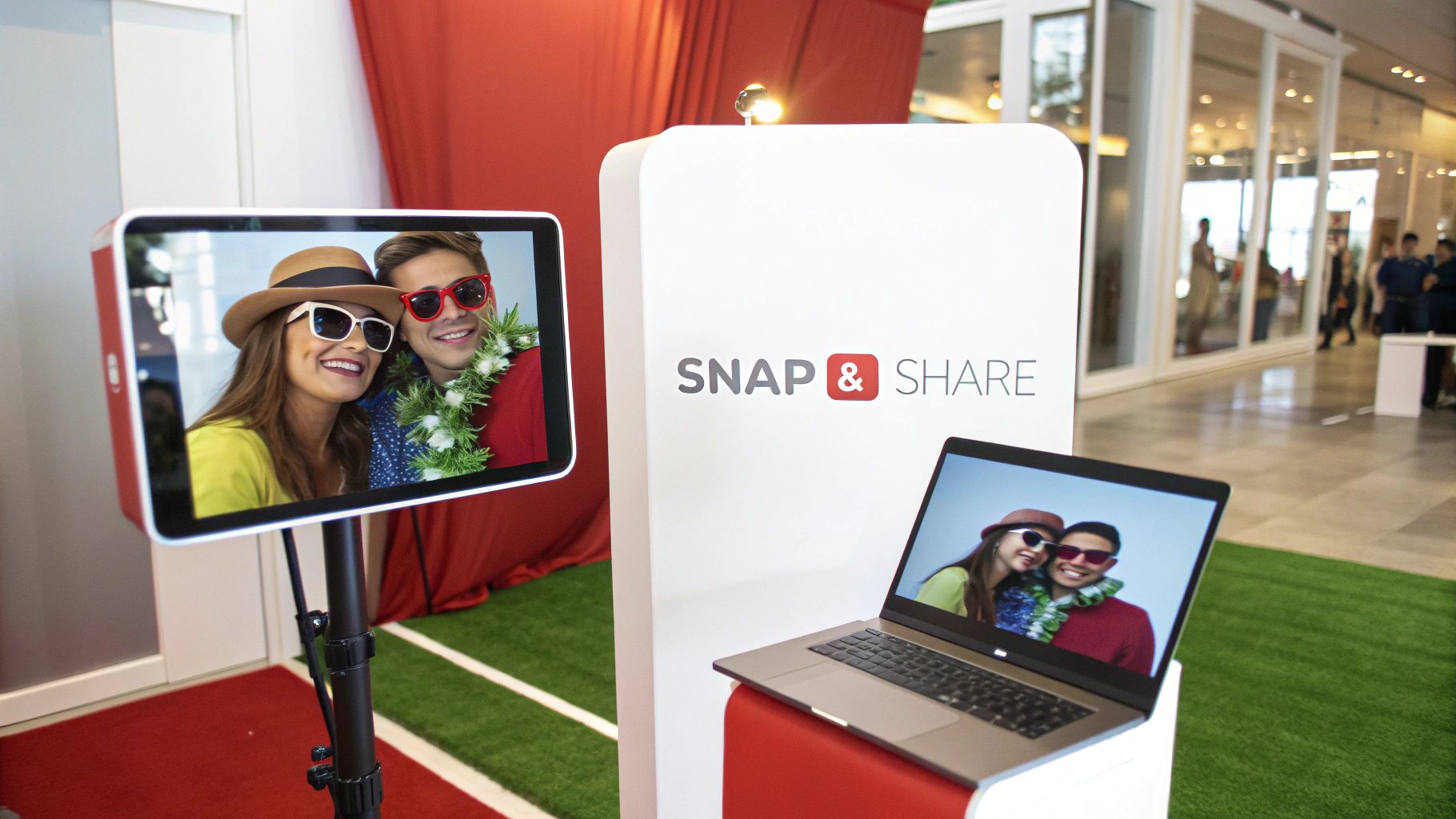
How it Works: Virtual photo booths function much like their physical counterparts, but exist entirely online. Attendees access the booth through the event platform or a dedicated link. They can then choose from a range of customizable digital backgrounds, branded frames, and stickers to personalize their photos. Many platforms also offer GIF creation capabilities and filters. With integrated social sharing features, attendees can instantly post their creations to platforms like Twitter, LinkedIn, and Instagram, often with pre-populated event hashtags.
Successful Implementations:
- South by Southwest (SXSW): SXSW's virtual edition utilized augmented reality (AR) filters that placed attendees in iconic Austin locations, offering a unique, shareable experience tied to the event's physical location.
- Adobe MAX: This conference implemented a virtual photo booth where participants could leverage Creative Cloud effects to personalize their photos, aligning with the brand's focus on creativity and design.
- Coachella: Coachella's virtual experience featured shareable frames incorporating festival artwork and performer imagery, capturing the vibrant atmosphere of the event.
- VidCon: This online video conference created animated GIF booths where influencers and fans could create content together, fostering interaction and community.
Actionable Tips:
- Seamless Integration: Integrate booth access directly within the main event platform to ensure a smooth user experience.
- Thematic Tie-ins: Create themed photo opportunities related to keynote messages or overarching event themes to reinforce key takeaways.
- Incentivize Sharing: Encourage participation by offering incentives for social sharing, such as contest entries, prize drawings, or exclusive digital badges.
- Live Social Wall: Feature a live social wall displaying attendee-shared content to amplify the reach of user-generated content and create a sense of community.
- Diverse Filter Options: Offer both professional and fun filter/frame options to cater to different attendee preferences.
- Marketing Integration: Design frames that subtly incorporate event information (hashtags, dates, website URLs) to extend marketing reach.
- Strategic Timing: Create special photo opportunities during key moments, such as virtual afterparties or networking sessions.
Pros & Cons:
Pros:
- Extends event reach through attendee networks.
- Creates user-generated content for event marketing.
- Provides attendees with personalized mementos.
- Increases brand visibility and recall.
- Offers additional sponsorship opportunities.
- Easy to implement with specialized platforms.
Cons:
- May not resonate with all audiences, particularly in more professionally-focused B2B settings.
- Requires active promotion to ensure adoption.
- Can appear gimmicky if not thoughtfully integrated with the event theme.
- Potential social sharing privacy concerns for some attendees.
When and Why to Use This Approach:
Virtual photo booths are a valuable virtual event engagement idea for events aiming to generate excitement, boost social media presence, and foster a sense of community. They are particularly effective for conferences, festivals, product launches, and brand activations. However, for highly professional or technical B2B events, their effectiveness should be carefully considered.
Why This Item Deserves its Place on the List: In the increasingly digital landscape, maximizing event reach and engagement is crucial. Virtual photo booths provide a concrete, actionable strategy to achieve these goals by leveraging the power of social media and user-generated content. They offer a unique blend of fun and functionality, making them a valuable addition to any virtual event seeking to boost engagement and amplify its message. This approach offers tangible benefits for Fortune 100 companies, tech startups, corporate marketing teams, venture capital firms, and event coordinators alike, making it a valuable asset in the virtual event toolkit.
7. Celebrity Entertainment and Live Performances
Injecting energy and excitement into your virtual event is crucial for maintaining audience engagement and combating digital fatigue. One highly effective virtual event engagement idea is incorporating celebrity entertainment and live performances. These segments provide engaging breaks from traditional content, creating memorable shared experiences that boost attendance and generate buzz. This approach is particularly valuable for Fortune 100 companies, tech startups, corporate marketing teams, venture capital firms, and event coordinators looking to elevate their online events.
How it Works:
Live performances and entertainment segments can take many forms, from musical performances and comedy acts to magic shows and celebrity cooking demonstrations. These segments offer a dynamic shift in pace, appealing to emotional connection and fostering a sense of community among attendees. By offering something beyond standard presentations and panels, you create an experience that resonates and leaves a lasting impression.
Features:
- Live musical performances
- Comedy sets or improv shows
- Magic or mentalist performances
- DJ sets for virtual happy hours
- Celebrity cooking demonstrations
- Live art creation
- Interactive performances with audience participation
Benefits:
- Creates memorable moments that differentiate your event: A unique performance can be the talk of the virtual town, setting your event apart from the competition.
- Provides natural breaks from informational content: Attendees need breaks, and entertainment offers a refreshing change of pace from dense presentations.
- Boosts attendance and reduces drop-off during multi-day events: The promise of exciting entertainment can incentivize attendance and keep participants engaged throughout longer events.
- Generates social media sharing and post-event buzz: Memorable performances create shareable moments, extending your event's reach and generating valuable word-of-mouth marketing.
- Appeals to emotional connection rather than just intellectual engagement: Entertainment taps into emotions, creating a deeper connection with your audience.
- Creates shared experiences that bond attendees: A shared experience like a live performance fosters a sense of community among virtual participants.
Pros and Cons:
Pros: See "Benefits" above.
Cons:
- Can be costly depending on talent level: Securing high-profile talent can require a significant budget.
- May not appeal to all audience segments: Carefully consider your audience demographics when selecting performers.
- Requires additional technical coordination: Live performances add complexity to your technical setup.
- Risk of technical difficulties during live performances: Have backup plans in place to mitigate potential issues.
- Needs careful integration to avoid feeling disconnected from main content: Ensure the entertainment aligns with your event's overall theme and messaging.
Examples of Successful Implementation:
- Salesforce's Dreamforce: Featured performances by Metallica and Foo Fighters.
- Cisco Live: Included exclusive sets by comedy performers from Saturday Night Live.
- Microsoft Ignite: Featured a virtual concert by Imagine Dragons.
- Zoom's Zoomtopia: Included a cooking demonstration by celebrity chef Marcus Samuelsson.
- HubSpot INBOUND: Featured a virtual cocktail class with award-winning mixologists.
Tips for Implementation:
- Choose performers who resonate with your audience demographics: Research your audience's interests to select talent that will generate excitement.
- Schedule entertainment strategically to combat digital fatigue: Place performances at key points in your agenda to maintain energy levels.
- Consider time zone differences when scheduling live performances: Maximize accessibility for a global audience.
- Incorporate audience interaction elements when possible: Q&A sessions, polls, or virtual meet-and-greets can enhance engagement.
- Create VIP meet-and-greet opportunities as premium offerings: Offer exclusive experiences for sponsors or high-value attendees.
- Have a technical backup plan (like pre-recorded performances): Be prepared for unexpected technical issues.
- Use entertainment to reinforce event themes and messages: Integrate the entertainment seamlessly into your overall event narrative.
Popularized By: Dreamforce, Web Summit, SXSW Interactive, Adobe MAX, Twitch
This virtual event engagement idea deserves its place on the list because it offers a powerful way to create memorable experiences, combat digital fatigue, and boost attendee engagement. By carefully planning and executing live entertainment segments, you can elevate your virtual event and achieve your event goals. This strategy is especially relevant for those seeking impactful virtual event engagement ideas, ensuring their online events are dynamic, engaging, and leave a lasting positive impression.
8. Virtual Swag and Digital Gift Boxes
Virtual swag and digital gift boxes are a powerful virtual event engagement idea, transforming the traditional conference giveaway into a dynamic and engaging experience for the digital age. This approach recreates the excitement of physical gifts within the virtual realm, offering a tangible connection that boosts attendee engagement and strengthens brand recall. These curated packages can combine digital assets, physical goods, and exclusive experiences, extending the event's impact far beyond the screen and into attendees' homes. This strategy is particularly effective for Fortune 100 companies, tech startups, corporate marketing teams, venture capital firms, and event coordinators looking to elevate their virtual events.
How it Works:
Virtual swag bags and digital gift boxes go beyond simply sending a digital gift card. They offer a curated experience, often themed around the event itself. Imagine receiving a box filled with branded items related to the keynote speaker's topic, or a digital package granting access to exclusive content and premium subscriptions. This personalized approach creates a memorable and shareable experience.
Features and Benefits:
These packages can include a variety of elements:
- Digital Gift Cards and Vouchers: For app stores, food delivery services, or online retailers.
- Physical Swag Delivered to Homes: Branded merchandise, event-themed items, or practical tools.
- Exclusive Content Access: Ebooks, templates, online courses, or early access to product releases.
- Virtual Subscription Boxes: Curated digital content delivered regularly, extending engagement beyond the event.
- Premium App Subscriptions: Access to software or services relevant to the event's theme.
- Charitable Donations in Attendees' Names: Aligning your event with a social cause.
- Meal Delivery Credits for Virtual Networking Lunches: Facilitating connection and shared experiences during online networking breaks.
- Interactive Unboxing Experiences: Gamified elements or augmented reality features to enhance the opening of physical or digital boxes.
Examples of Successful Implementation:
- Adobe MAX: Sent creative kits with art supplies for hands-on workshops, directly engaging attendees with the presented content.
- Salesforce Connections: Shipped themed boxes with snacks and branded items related to session themes, reinforcing key messages and creating a cohesive event experience.
- Microsoft Build: Provided digital gift cards for meal delivery during networking sessions, fostering a sense of community and shared experience even in a virtual setting.
- HubSpot INBOUND: Created tiered swag boxes based on ticket level, offering exclusive perks and recognizing different levels of attendee investment.
- AWS re:Invent: Sent customized tech accessories with conference branding, providing practical and valuable items that attendees could use long after the event.
Pros:
- Creates a tangible connection to virtual events, increasing engagement and brand recall.
- Increases perceived event value, justifying ticket prices and attracting higher-level attendees.
- Provides sponsor activation opportunities, allowing brands to connect with attendees in a meaningful way.
- Generates pre-event excitement when announced in advance, driving registrations and building anticipation.
- Creates shareable moments as attendees receive packages, extending the event's reach on social media.
- Can be more targeted and personalized than traditional swag, maximizing impact and relevance.
- Potentially more sustainable than traditional conference giveaways, particularly with digital options.
Cons:
- Logistics of physical delivery can be complex, requiring detailed planning and coordination.
- International shipping creates fulfillment challenges, potentially excluding some attendees or increasing costs.
- Higher cost per attendee than many digital-only engagement strategies, requiring careful budget allocation.
- Requires earlier planning and attendee information collection, impacting registration workflows.
- Risk of delivery delays or issues, potentially impacting attendee satisfaction.
- Difficult to accommodate last-minute registrants, potentially creating a sense of exclusion.
Tips for Implementation:
- Consider an opt-in approach to respect attendee privacy and reduce waste.
- Create unboxing experiences that can be shared on social media, amplifying your event's reach.
- Time physical deliveries to arrive just before the event, maximizing excitement and relevance.
- Include both practical and fun items that relate to your content, reinforcing key messages and providing value.
- Provide digital alternatives for international attendees, ensuring inclusivity and minimizing logistical challenges.
- Use QR codes on physical items to connect to digital experiences, bridging the physical and virtual worlds.
- Partner with sponsors to share costs and enhance offerings, creating mutually beneficial partnerships.
- Consider eco-friendly options to align with sustainability goals, demonstrating corporate responsibility.
When and Why to Use This Approach:
Virtual swag and digital gift boxes are ideal for virtual events aiming to create a premium experience, foster a strong sense of community, and leave a lasting impression on attendees. They are particularly effective for events with a clearly defined target audience and a focus on providing tangible value beyond the virtual sessions. Learn more about Virtual Swag and Digital Gift Boxes. This approach is a strong virtual event engagement idea because it addresses the challenge of creating memorable experiences in a digital environment. By providing tangible touchpoints, you can deepen attendee engagement and build stronger connections with your brand. Popularized by companies like Swag.com, Sendoso, Alyce, Postal.io, and Cultivate Premium Corporate Gifts, this strategy has proven to be an effective way to boost virtual event engagement.
9. AI-Powered Matchmaking and Networking
Boosting virtual event engagement is a top priority for Fortune 100 companies, tech startups, corporate marketing teams, venture capital firms, and event coordinators alike. One of the most innovative and effective virtual event engagement ideas is AI-powered matchmaking and networking. This technology transforms the often-awkward virtual networking experience by leveraging sophisticated algorithms to connect attendees based on shared interests, professional goals, backgrounds, and even desired outcomes. This eliminates the randomness of traditional networking, leading to more meaningful interactions and a significantly improved experience. Learn more about AI-Powered Matchmaking and Networking
Instead of leaving connections to chance encounters in a virtual hallway, AI-powered matchmaking uses data-driven recommendations to pre-qualify potential connections. This targeted approach saves attendees valuable time and reduces the anxiety often associated with networking, especially for introverts. The system analyzes attendee profiles, including interests, goals, industry, and experience, to suggest relevant matches. This can involve smart recommendations for relevant sessions, contacts, and even pre-scheduled one-on-one meetings.
Features often include interest and goal-based matching algorithms, smart recommendations for sessions and relevant contacts, pre-scheduled networking meetings, digital business card exchange, conversation starter prompts to break the ice, post-event follow-up facilitation, connection strength scoring, and integration with professional networks like LinkedIn.
Examples of Successful Implementation:
Several high-profile events have demonstrated the effectiveness of AI-powered matchmaking:
- Web Summit: Their platform uses AI to suggest meetings based on mutual interests, ensuring attendees connect with relevant individuals.
- Microsoft Ignite: "Microsoft Scheduler" facilitated connections with experts, enhancing the value of the event for attendees.
- SXSW: Their AI matchmaking system scheduled over 50,000 meetings, showcasing the scalability of this technology.
- Collision Conference: Interest-based algorithms created "connection pods," fostering focused discussions within smaller groups.
- CES: A reputation-based system measured connection quality, further refining the matching process.
Pros:
- Creates more relevant connections than traditional networking methods.
- Saves time by pre-qualifying potential connections.
- Reduces networking anxiety by providing structured interaction formats and conversation starters.
- Increases overall networking satisfaction and outcomes.
- Provides valuable data on attendee interests and behavior for future event planning.
- Scales effectively for events of any size.
- Helps introverts navigate networking more comfortably.
Cons:
- Requires attendees to complete detailed profiles, which can be a barrier to entry.
- Algorithm quality varies significantly between platforms; choosing the right platform is crucial.
- Can feel impersonal if poorly implemented, lacking the organic feel of spontaneous connections.
- May create privacy concerns for some attendees regarding data sharing.
- Limited effectiveness if attendee participation rates are low.
- Technical issues can disrupt scheduled meetings.
Tips for Effective Implementation:
- Incentivize complete profile creation: Offer rewards or premium features for attendees who provide detailed information.
- Provide clear instructions: Explain how the matching system works to encourage adoption and maximize its effectiveness.
- Offer choice: Provide both algorithm-matched and self-selected networking opportunities to cater to different preferences.
- Structure interactions: Create structured conversation formats for matched attendees to facilitate meaningful discussions.
- Pre-event matches: Send pre-event match notifications to allow attendees to research potential connections.
- Filtering options: Include robust filtering options to allow attendees to refine their match preferences.
- Feedback mechanisms: Gather feedback to continuously improve the match quality and address any concerns.
- Conversation starters: Offer tailored "conversation starter" prompts based on shared interests to break the ice.
Popular Platforms: Brella, Grip, Swapcard, Hopin, and Braindate by e180 are among the popular platforms offering AI-powered matchmaking features.
By thoughtfully implementing AI-powered matchmaking, event organizers can significantly enhance the networking experience, driving engagement and delivering measurable value for attendees. This technology provides a powerful tool for creating more targeted, efficient, and ultimately, more successful virtual events.
10. Interactive Product Demonstrations and Virtual Exhibits
Interactive product demonstrations and virtual exhibits are a powerful virtual event engagement idea, transforming passive viewing into active participation. Instead of static displays or pre-recorded videos, this approach leverages technology to create immersive experiences that mimic and often surpass the benefits of in-person product showcases. This makes them a crucial consideration for Fortune 100 companies, tech startups, corporate marketing teams, venture capital firms, and event coordinators looking to maximize impact at their virtual events.
These virtual exhibits utilize various technologies, including 3D models, augmented reality (AR), and virtual reality (VR), to allow attendees to explore products in detail, ask questions, and experience capabilities firsthand. Imagine navigating a 360-degree view of a new car model, customizing its features in real-time, or even virtually "sitting" in the driver's seat – all from the comfort of their own homes. This level of interactivity significantly boosts engagement and leaves a lasting impression.
Features and Benefits:
Interactive product demonstrations offer a wealth of features, including:
- 360-degree product views and 3D models: Allowing attendees to examine products from all angles.
- Augmented reality (AR) product visualization: Overlaying digital product images onto the real world through smartphones or tablets.
- Virtual reality (VR) immersive environments: Creating fully immersive experiences where attendees can interact with products in simulated scenarios.
- Live demonstrations with interactive elements: Real-time demonstrations with interactive elements like polls, quizzes, and Q&A sessions.
- On-demand product experts: Availability of experts to answer questions and provide detailed information.
- Real-time Q&A capabilities: Facilitating instant interaction between attendees and product specialists.
- Virtual exhibit halls with booth navigation: Simulating the experience of walking through a physical exhibit hall.
- Digital product sampling: Providing virtual samples or trials of products.
- Product customization simulators: Allowing attendees to customize products and see the results in real-time.
Pros and Cons:
Pros:
- Creates more engaging product experiences than static displays.
- Allows detailed examination from any location.
- Provides data on which features generate most interest.
- Scales to accommodate unlimited simultaneous viewers.
- Reduces travel costs for both exhibitors and attendees.
- Can be archived for post-event access.
- Enables real-world application visualization.
Cons:
- Requires specialized technical development.
- High-quality experiences can be expensive to produce.
- May require downloads or specific browser capabilities.
- Limited tactile experience compared to physical demos.
- Technical issues can significantly impact effectiveness.
- Learning curve for attendees unfamiliar with virtual navigation.
Examples of Successful Implementation:
- Apple's virtual product launches feature AR-enabled product views, allowing potential customers to visualize new devices in their own environment.
- Cisco Live created a virtual network operations center where attendees could test security solutions in simulated environments.
- Audi developed VR showrooms where customers could configure and experience vehicles.
- Samsung's virtual exhibit hall allowed attendees to interact with new devices through 3D models.
- IKEA's virtual spaces showcase furniture in realistic room settings with interactive elements.
Tips for Effective Implementation:
- Focus on solving real customer problems rather than just showcasing features.
- Provide multiple interaction options to accommodate different technical capabilities and preferences.
- Include both guided and self-directed exploration options.
- Ensure easy access to human representatives for questions and support.
- Create scenario-based demonstrations that show products in context.
- Incorporate interactive challenges that highlight product capabilities.
- Offer simplified versions for users with bandwidth limitations.
- Provide takeaway resources that extend the experience beyond the event.
When and Why to Use This Approach:
This approach is ideal for virtual events where product showcasing and engagement are key objectives. It is particularly relevant for industries like technology, manufacturing, automotive, and retail, where demonstrating product functionality and features is crucial. This method excels at generating leads, building brand awareness, and driving sales.
Popularized By: Apple Events, CES Virtual, Unity Technologies, Autodesk, Nvidia GTC
By incorporating interactive product demonstrations and virtual exhibits into your virtual event strategy, you can effectively engage your audience, showcase your products in compelling ways, and achieve your event goals. This innovative approach positions your company as a leader in leveraging technology for virtual engagement, a vital differentiator in today's competitive landscape. Remember to prioritize user experience and ensure seamless technical execution to maximize the impact of this powerful virtual event engagement idea.
10-Strategy Virtual Event Engagement Comparison
| Strategy | 🔄 Implementation Complexity | ⚡ Resource Requirements | 📊 Expected Outcomes | 💡 Ideal Use Cases | ⭐ Key Advantages |
|---|---|---|---|---|---|
| Interactive Polling and Live Q&A | Low; easy integration | Minimal; requires stable internet and basic polling tools | Increased participation and real-time feedback | Webinars, Q&A sessions, and interactive conferences | Enhances engagement through live audience input |
| Gamification and Virtual Challenges | Moderate to high; requires planning | Requires specialized platforms and pre-event setup | High engagement and improved content retention | Competitive events, learning platforms, large conferences | Drives attendance via friendly competition and rewards |
| Breakout Rooms and Networking Lounges | Moderate; needs facilitation | Standard video conferencing and scheduling tools | Deepened connections and targeted discussions | Conferences, networking events, community-building sessions | Facilitates intimate group interactions and focused discussions |
| Interactive Workshops and Hands-on Labs | High; extensive technical preparation | Multiple tools, skilled facilitators, and collaboration aids | Improved knowledge retention and participant satisfaction | Training sessions, skill-building workshops, and labs | Offers practical, real-time learning and interactive experiences |
| Celebrity Guests and Surprise Appearances | Moderate to high; coordination intensive | Higher budget, celebrity management, and robust tech support | Increased attendance, media buzz, and audience excitement | High-profile events, product launches, and marketing events | Boosts event appeal through star power and shareable moments |
| Virtual Photo Booths and Social Media Integration | Low to moderate; easy integration | Customized digital assets and social media management | Greater brand visibility and organic content sharing | Brand activations, social events, and promotional campaigns | Generates fun, shareable content enhancing brand connection |
| Celebrity Entertainment and Live Performances | High; requires extensive coordination | High production costs, technical setup, and live streaming | Memorable moments and sustained audience engagement | Large-scale conferences, festivals, and entertainment events | Creates high-impact, lively breaks that rejuvenate the audience |
| Virtual Swag and Digital Gift Boxes | Moderate; involves logistic planning | Inventory management, delivery coordination, and digital tools | Elevated perceived event value and enhanced attendee satisfaction | Corporate events, hybrid experiences, and attendee giveaways | Provides tangible and personalized brand touchpoints |
| AI-Powered Matchmaking and Networking | High; advanced algorithm implementation | Requires robust data infrastructure and detailed attendee profiles | More meaningful, efficient, and targeted networking experiences | B2B events, professional conferences, and networking summits | Delivers personalized connections through data-driven matching |
| Interactive Product Demonstrations and Virtual Exhibits | High; involves advanced tech development | Investment in AR/VR, 3D modeling, and interactive platforms | Immersive product engagement and detailed exploration | Product launches, tech showcases, and trade events | Offers cutting-edge, interactive product experiences |
Elevate Your Virtual Event Engagement
From interactive polling and live Q&A sessions to incorporating gamification and virtual challenges, the ideas explored in this article offer a diverse toolkit for boosting audience participation in your online events. Mastering these virtual event engagement ideas is crucial for any organization looking to maximize the impact of their online gatherings. By leveraging breakout rooms, networking lounges, and even AI-powered matchmaking, you can foster meaningful connections and create a sense of community, regardless of physical location. Remember, highly engaging virtual events translate to increased brand awareness, stronger lead generation, and ultimately, a higher return on investment.
The most successful virtual events go beyond passive viewing and actively involve attendees. Whether it's through interactive workshops, celebrity appearances, virtual photo booths, or immersive product demonstrations, creating dynamic experiences is key. Consider incorporating personalized elements like virtual swag bags, including branded electronics, to leave a lasting impression. If you're looking to elevate the design and execution of your virtual event, exploring professional design and development services from Prakti Studio SRL can be invaluable for creating a seamless and engaging experience.
By carefully selecting and implementing these strategies, you can transform your virtual events from mundane webinars into vibrant, memorable experiences that resonate with your target audience – whether they're Fortune 100 companies, tech startups, or venture capital firms. Don't just host an event; create an experience.
Want to create truly memorable virtual swag bags that boost engagement and leave a lasting impression? Explore the possibilities of incorporating personalized branded electronics into your virtual event giveaways with Electronic Finishing Solutions. They offer a unique way to connect with your audience and enhance your brand presence long after the event concludes.

